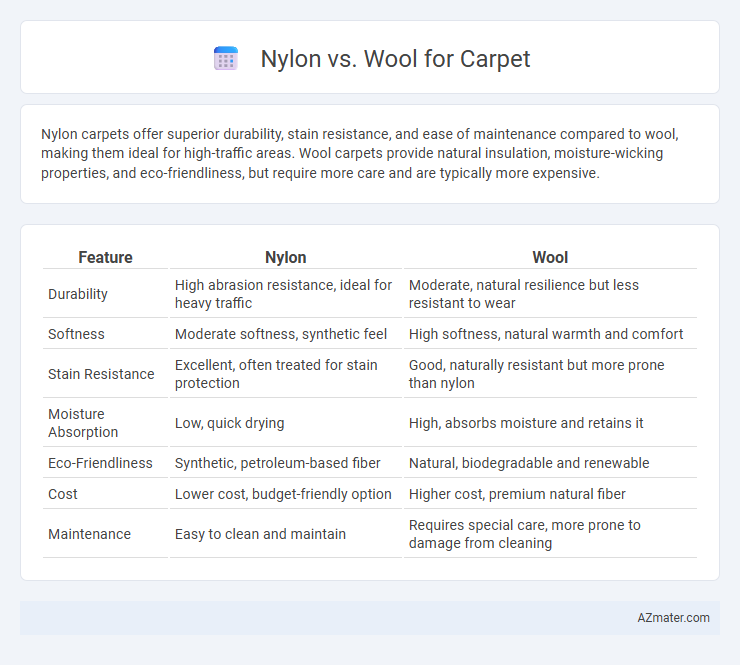Nylon carpets offer superior durability, stain resistance, and ease of maintenance compared to wool, making them ideal for high-traffic areas. Wool carpets provide natural insulation, moisture-wicking properties, and eco-friendliness, but require more care and are typically more expensive.
Table of Comparison
| Feature | Nylon | Wool |
|---|---|---|
| Durability | High abrasion resistance, ideal for heavy traffic | Moderate, natural resilience but less resistant to wear |
| Softness | Moderate softness, synthetic feel | High softness, natural warmth and comfort |
| Stain Resistance | Excellent, often treated for stain protection | Good, naturally resistant but more prone than nylon |
| Moisture Absorption | Low, quick drying | High, absorbs moisture and retains it |
| Eco-Friendliness | Synthetic, petroleum-based fiber | Natural, biodegradable and renewable |
| Cost | Lower cost, budget-friendly option | Higher cost, premium natural fiber |
| Maintenance | Easy to clean and maintain | Requires special care, more prone to damage from cleaning |
Introduction to Nylon and Wool Carpets
Nylon carpets are prized for their exceptional durability, resilience, and resistance to abrasion, making them ideal for high-traffic areas. Wool carpets, derived from natural fibers, offer superior insulation, softness, and natural stain resistance, contributing to a luxurious and eco-friendly flooring option. Both materials provide unique benefits, with nylon excelling in wear resistance and wool standing out for its comfort and sustainability.
Key Differences Between Nylon and Wool Carpet Fibers
Nylon carpets offer superior durability and stain resistance due to their synthetic polymer structure, making them ideal for high-traffic areas. Wool carpets, made from natural animal fibers, provide exceptional softness, insulation, and natural flame retardant properties but require more maintenance to avoid damage from moisture and pests. The key differences include nylon's higher resilience and easier cleaning versus wool's eco-friendliness and luxurious texture.
Durability and Longevity: Nylon vs Wool
Nylon carpets exhibit superior durability and resistance to wear, making them ideal for high-traffic areas, while wool carpets offer natural resilience and maintain their appearance over time with proper care. Nylon fibers are highly abrasion-resistant and can withstand heavy foot traffic without matting, whereas wool's natural elasticity helps it bounce back from crushing and retain its firmness. Despite nylon's strength, wool carpets tend to have a longer lifespan due to their ability to resist dirt and stains naturally, contributing to enhanced longevity in less aggressive environments.
Comfort and Texture Comparison
Nylon carpets offer a smooth, resilient texture that maintains softness underfoot and resists crushing, making them comfortable for high-traffic areas. Wool carpets provide a naturally plush and warm feel with superior cushioning due to their dense fiber structure, enhancing comfort and insulation. The choice between nylon and wool for carpet comfort depends on the desired combination of durability and luxurious softness.
Stain Resistance and Maintenance
Nylon carpets offer superior stain resistance due to their durable, synthetic fibers treated with advanced stain-repellent coatings, making them easier to clean and maintain in high-traffic areas. Wool carpets, while naturally resilient and luxurious, tend to absorb stains more readily and require specialized cleaning methods to maintain their appearance and longevity. Regular vacuuming and prompt stain treatment are essential for wool, whereas nylon demands less frequent and less intensive maintenance, providing a more practical solution for households prone to spills and dirt.
Environmental Impact and Sustainability
Nylon carpets, derived from synthetic polymers, contribute to environmental concerns due to their reliance on non-renewable petroleum resources and low biodegradability, leading to longer landfill presence. Wool carpets offer a sustainable alternative with natural biodegradability, renewable sourcing from sheep, and lower carbon footprint through carbon sequestration in sheep grazing ecosystems. However, wool production requires significant land and water resources, making its sustainability dependent on agricultural practices and regional environmental management.
Allergen and Indoor Air Quality Concerns
Nylon carpets tend to be less hypoallergenic compared to wool, as nylon fibers can trap allergens such as dust mites and pet dander more easily, potentially affecting indoor air quality negatively. Wool naturally resists allergens due to its lanolin content, which repels dust mites and inhibits mold growth, improving indoor air quality for sensitive individuals. Choosing wool carpets can contribute to a healthier indoor environment by minimizing allergen accumulation and supporting better air quality.
Cost and Value Analysis
Nylon carpets typically cost between $3 to $7 per square foot, offering high durability and stain resistance that justifies the price for heavy-traffic areas. Wool carpets, priced around $8 to $15 per square foot, provide natural insulation and luxury but require more maintenance, making them less cost-effective for budget-conscious buyers. Evaluating the long-term value, nylon's resilience often leads to lower replacement and cleaning expenses, whereas wool's premium feel suits spaces where comfort outweighs cost.
Ideal Usage Scenarios for Nylon and Wool Carpets
Nylon carpets excel in high-traffic areas such as hallways, offices, and family rooms due to their exceptional durability, stain resistance, and resilience to wear. Wool carpets are ideal for low-traffic, formal spaces like living rooms and bedrooms where their natural softness, insulation properties, and eco-friendliness enhance comfort and aesthetics. Choosing nylon suits environments requiring easy maintenance and longevity, while wool is preferred for luxury, warmth, and natural fiber benefits.
Final Recommendation: Choosing Between Nylon and Wool
Nylon carpets offer superior durability, stain resistance, and cost-effectiveness, making them ideal for high-traffic areas and households with pets or children. Wool carpets provide natural insulation, eco-friendliness, and a luxurious feel, suitable for low-traffic spaces seeking comfort and sustainability. Choosing between nylon and wool depends on balancing budget constraints, maintenance preferences, and the desired carpet lifespan.

Infographic: Nylon vs Wool for Carpet
 azmater.com
azmater.com